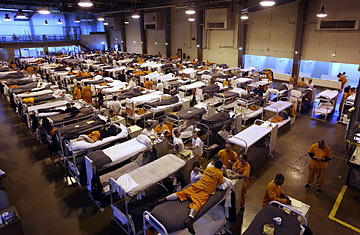
Several hundred inmates crowd the gymnasium at San Quentin prison in San Quentin, Calif.
Americans famously overspent during the 1990s and early '00s. It's a familiar story: we mortgaged oversized homes to buy colossal TVs. But you may have heard less about another commodity we binged on: justice. Americans indulged in an enormous criminal-justice spending spree during the past 25 years, locking up more and more offenders (particularly for drug-related crimes) for longer and longer sentences. Total spending on incarceration rose from $39 per U.S. resident in 1982 to $210 per resident in 2006, according to the most recent figures from the Justice Department. We now spend $62 billion a year on corrections, and about 500 of every 100,000 Americans are behind bars. As recently as the 1970s, the figure was only 100 in 100,000.
Owing to budget crises, many states are now having trouble affording to keep so many people locked up. Some states are cutting incarceration expenses by consolidating prisons; some are trying to slash prison-food and health-care costs. But real savings come only when you reduce prison populations, and so some states — including California, Colorado and Kentucky — have begun releasing inmates early. "The pressure in state legislatures all over the country is to bring down the populations, because we just can't afford the level of punishment that we've had the last 20 years," says Joan Petersilia, a criminologist at Stanford Law School.
Early-release programs can save states huge sums — $45 million a year in Colorado, for instance — but at what cost? One worry is that crime will rise if inmates are let go before completing their sentences. Republican Scott Suder, a Wisconsin assemblyman, crystallized a deeper concern, a moral one, when he told the Wisconsin State Journal in June that early release amounts to "rewarding bad behavior."
Criminologists say little research has been conducted to determine whether early-release initiatives lead to higher crime rates, although some prisoners who get out will undoubtedly commit crimes that they wouldn't have been able to commit if they were still behind bars. "There's no risk-free early-release program," says Jeremy Travis, president of John Jay College of Criminal Justice in New York City. But early release doesn't simply mean opening the gates and letting inmates run for it. No state is freeing sex offenders, murderers or habitually violent criminals. Most inmates who are eligible for early release are those who were caught with relatively small amounts of drugs. And generally, early-release guidelines require that inmates be within six months of their official exit date.
It's possible that in some cases, particularly with first-time, nonviolent offenders, early-release initiatives could actually help reduce crime. "There are two effects of incarceration," says criminologist Alfred Blumstein of Carnegie Mellon University in Pittsburgh, Pa. "One is specific deterrence — you go to prison, and you say, 'Holy s___, I don't want to go through that again.' That is the crime-reducing component of prison. But the other effect of incarceration is criminalization. You have connection with gangs. You have diminished opportunities after you get out — and therefore you have some higher chance of returning to crime. Lots of researchers have tried to sort out the strength of these two effects, without much success. With early release, then, the question becomes, Does it make them more criminal because they think, 'I got away with it,' or less criminal because they think, 'The system has been really nice to me'? No one knows the answer."
States can mitigate the risk of recidivism by providing inmates with job skills, drug treatment and other services they will need to reintegrate into the community. "Most recidivism occurs within the first three years," Blumstein says. "There need to be a lot of efforts targeted at people just coming out."
Some states, like Colorado, are launching new efforts to help the recently released find housing and secure other social services. California has allocated some $42 million for an entire re-entry facility — a former prison for women — where inmates within a year of release will get training and, if needed, substance-abuse counseling. But other states may be flirting with disaster by cutting re-entry programs even as they let some inmates go early. The state of Washington was having trouble releasing some of its inmates early because they had no place to live. Now the state is helping roughly 700 offenders pay up to $500 per month in rent. At the same time, however, the state has cut funding for more substantive transitional services.
The politics of early release are delicate. The prison boom of the past 25 years benefited a great many politicians who could claim to be tough on crime. One can easily imagine the political ads that will air in the next cycle in attempts to defeat elected officials who vote not only to set prisoners free but also to spend more on social services for them.
That's why some states are opting not to open the cells of current inmates. Instead, they're making it harder for those who are already out on parole to return to prison. Parolees who commit minor infractions — missing a meeting with a parole officer, for instance — account for an astonishing proportion of incarceration costs. "Every year," Stanford's Petersilia told the Los Angeles Times recently, "[the state of California] sends some 70,000 parolees back to prison, about 30,000 from L.A. County alone. Most serve two to three months. Everybody knows this revolving door does not protect the public ... These are the lower-level people who may have been in drug treatment [on the outside], may have found a job. When you send them back to prison, you break those connections."
In short, sometimes being tougher on crime requires a softer approach like early release. But try explaining that in a 30-sec. ad in the next election cycle.
